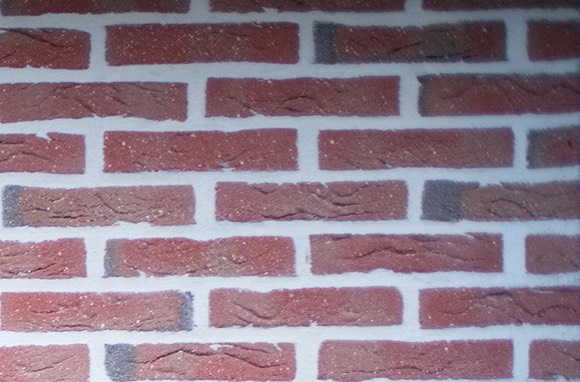Zeiss OTUS 55 versus Leica SX 50 ASPH
The comparison between Zeiss OTUS 55 and Leica SX 50 is extremely interesting because of the many themes that are addressed. To start a report with the most important conclusion is perhaps not the usual thing to do. It is justified in this case, because adjacent topics are the more interesting ones. Based purely on measurable and objective facts the OTUS finishes indeed by a hair('s) breadth as first at the finish line. The OTUS wide open and even stopped down to f/5.6 shows a better edge performance, visible at a higher definition (contrast and resolution combined) of the fine textural details of bricks. The OTUS and the SX ASPH at f/1.4 visibly vignet at the corners, a common way of reducing aberrations at the edge of the image. The main center portion of the image area shows no performance difference between the OTUS and SX 50 ASPH, at least not when both lenses are attached to the Leica M (the OTUS with the Novoflex Leica-Nikon adapter). Focusing was obviously in Live View modus. It might be that the sensor resolution of the M limits the ultimate quality differences, but that in itself is an important signal. Many reviewers have been impressed and possibly mislead by the very high MTF values of the OTUS, especially the 70% contrast at the 40 line-pairs/mm, compared to the numerically significantly lower values of the SX 50 ASPH. But it is well-known that at these levels of detail resolution a contrast difference of at least 10 percentage points is needed to produce some difference in perceptual image quality.
To find the limits of both lenses I also used microfilm that can resolve at least 125 linepairs when the body is put on a tripod. I bought a Nikon FM to use the OTUS and used my Leica M-A for the SX ASPH. Again the differences are within the margins of statistical tolerance and cannot be used as definite benchmarks to state the superiority of one lens above the other.
Testing the lens under strict conditions, tripod, focus aids and so on is fine for establishing a benchmark, but the real litmus test is the way these results can be reproduced in practical situations. A high-speed lens generally has not been designed for photographing landscapes or a back yard set-up in bright sunlight at the aperture of f/1.4, but for handheld picture taking in hardly available light. The narrow depth of field can be used with good effect for portraits to focus attention to the eyes, but this technique can be overhyped as a fad.
Handheld shooting with the OTUS is a mixed blessing at best. The lens has an extremely smooth focusing movement that is really a joy to use. The volume and weight of the lens however makes handheld shooting with the lens wide open and at distances from 1 to 5 meters a lottery and any advantages of image quality are lost.
The SX 50 ASPH on the other hand has a shorter draw of the focusing ring and this makes focusing a bit less refined, but the volume and weight is such that every picture is a hit.
When we combine both groups of parameters (the optical qualities and the ergonomic qualities) the SX 50 ASPH wins the contest with ease. The volume of the OTUS makes it impractical to become the premium standard lens it claims to be. There is no doubt that the lens produces superb images even at the widest aperture under studio conditions but that is not the domain of such a lens. It is evident that the designers of the OTUS put prestige above practicality. When you look at the size and volume and the number of lens elements, it is clear that every effort has been made to design the ultimate high-speed lens. But in their goal setting the designers fell in the classical Zeiss trap that bedeviled the Contarex system. Then the lens designs were not restricted by size and could grow to whatever size was necessary to get the required image quality. As we all know the Contarex system was not a success, even accepting the high performance of the lenses.
The Leica designers follow a different philosophy: the size is given and the lens quality is a derivative of the size. All the more reason to appreciate the image quality of the SX 50 ASPH. The SX 50 ASPH can still claim to be the best high-speed standard lens available in the photographic world today. The performance/volume ratio is unequalled and when we consider the additional effort that was needed to construct the OTUS and its marginal improvement compared to the SX, it is evident that the Zeiss marketing people had another goal in mind. The OTUS is without doubt a most prestigious lens and clearly appeals to buyers who want to show their taste for selecting the best one can buy.
In the past there was a visible quality gap between a f/1.4 lens and a f/2.0 lens. The f/2.0 design was the true standard lens, useful for every assignment from close up to landscape and from bright light to twilight. The very high-speed lens of aperture 1.4 was designed to cope with even less ambient light and still produce good pictures with acceptable shadow detail and high light rendition. The f/1.4 lens has always been accepted as a specialist design to complement the more mundane but much more versatile f/2.0 design.
When the Leica SX 50 ASPH came on the market it was evident that a new species had been created. This was the first very high speed design that could challenge the established f/2 lenses. Leica accepted the consequence and designed the Apo-Summicron to set a new standard for an universal standard lens. The OTUS shows that the economic law of marginal utility still works in lens design: a small incremental improvement needs a huge amount of effort and we may ask whether the result is worth the effort. My reaction is a simple answer in the negative. I am impressed by the progress in performance, compared to the normal Planar f/1.4 design, but in addition to the scientific approach, there is also a practical approach. Mercedes-Benz once made the error to revive the Maybach marque to create a luxury car without limits. The brand failed miserably. The OTUS is the Maybach in todays' optical landscape. There is indeed no equal, but who wants to use this lens when the number two (the Leica SX 50 ASPH) delivers almost the same performance without the drawbacks. I want to add immediately that designing a SLR lens is not the same as designing a CRF lens, but that is not the issue nor an excuse.
In the not so distant past there was a clear distinction in a lens line between special lenses and universal or standard lenses. The adjective ‘universal’ referred to a lens that could be used in all situations and for every goal. In practice however there were lenses for several categories of work: macro lenses, high-speed lenses, high-fidelity lenses and so on. In the second half of the previous century the miniature camera system (35 mm) became the dominant photographic tool with universal appeal, relegating the medium and large format systems to a niche position. The miniature camera (first in rangefinder construction and later in reflex construction) was usually equipped with a 50 mm or 55 mm so-called ‘standard’ lens, because of its justified versatility and its unjustified claim that the angle of view of the human observer coincided with the angle of view of the 50 mm lens, thus providing a natural look. The standard lens had an aperture of f/2 and was designated as the universal lens, because of its rigorous and scientific control of aberrations and high definition at all apertures and object distances. The latest version of this approach can be seen in the Apo-Summicron-M 1:2/50 mm ASPH FLE. The specialist lens for (non-existing) available light photography was the f/1.4 design, that offered twice the light collecting power, but had a lower level of aberration control. Using such a specialist lens (and there were also f/1.2 and even f/1.0 (f/0.95)) the photographer knew that some concessions in image quality had to be accepted, but the advantage was basically to have the opportunity to get the impossible picture. The main problems with such high-speed lenses was the occurrence of flare and secondary reflections and a loss of contrast in shadow areas of the scene. The photographer had to choose between a high-definition and a high-speed lens or buy both to select the appropriate one to suit the occasion.
One of the first lenses to cut this Gordian knot was the Leica Summilux-M 1.4/50 mm ASPH FLE, a design that combined high definition and high speed and could be used at close range even at wider apertures. The new generation of high-speed lenses, produced by Zeiss and Sigma claim to expand the range of universality and even claim to bring medium format quality into the 35 mm sensor sized cameras with high pixel count. The main data of the lenses are (Zeiss and Leica)
Focal length: 55 mm and 51.6 mm
Aperture 1.4 and 1.4
Focus range: 0.5 meters and 0.7 meters to infinity
Number of elements/groups: 12/10 and 8/5
Filter size: M77 and E46
Dimensions (length, diameter, weight): 141 mm, 83 mm, 970 grams and 52.5 mm, 53.5 mm, 335 grams
The notion of a universal lens is a bit strange as this would imply that you could use the lens for available light photography at f/1.4 and also for landscapes at the same aperture. While it can be done, it is not the logical approach. A picture of a landscape is often made at medium (stopped down) apertures and in this case the wide open performance is less interesting. If you tend to buy a high-speed lens, it is the performance at the wider apertures that would be of overriding importance.The first test I made is the Siemens star test evaluated with the Image Engineering software. The results for the Zeiss and Leica lens are shown below for f/1.4 and f/5.6. At f/1.4 the differences are very small. The Siemens star is divided in 8 segments and every segment has its own colored line. When the lines are very close together there is no difference in contrast and resolution that depends on orientation of the lines. The OTUS has slightly higher MTF values in the lower frequencies, but this is only visible on the test-charts, not in practice. Both lenses show the same limiting resolution of 1500 lp/ph or 62.5 lp/mm.
Below: OTUS 55 at f/1.4
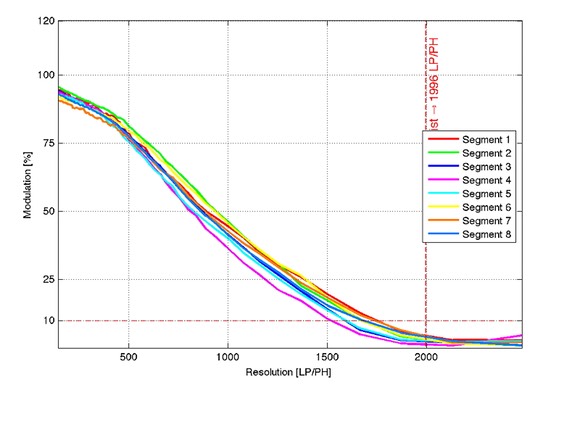
Below: SX 50 at f/1.4
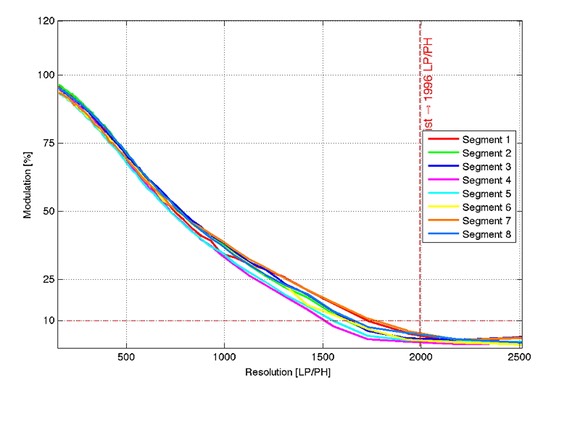
Below: OTUS ar f/5.6
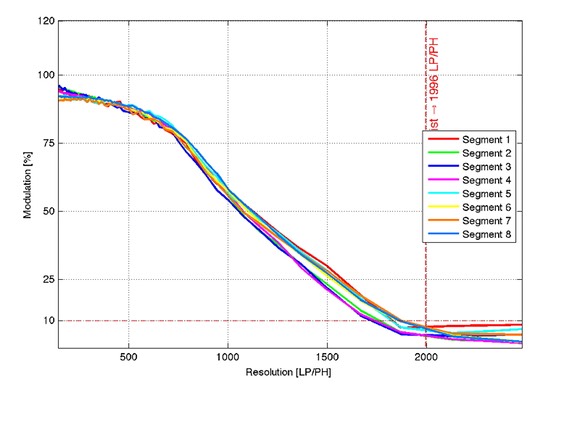
Below: SX 50 at f/5.6
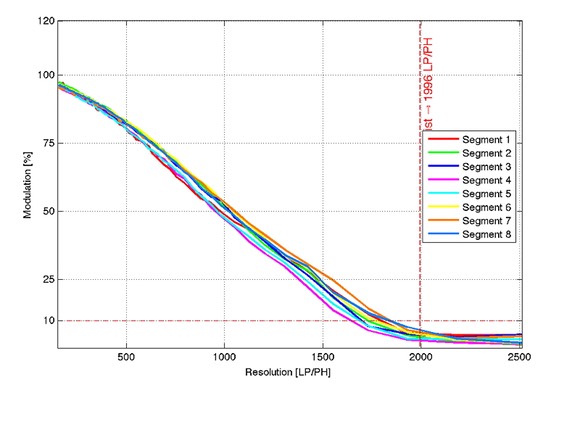
At f/5.6 both lenses naturally improve in image quality, and the limiting resolution is now 2000 lp/ph or 83 lp/mm. The Zeiss lens shows again a higher MTF at the lower frequencies around 20 lp/mm and this should become detectible if one believes the theory.
A word on the test conditions. I always use ambient light of low contrast, because this type of light defines the worst conditions and I assume that a buyer of these lenses would want to know what the minimum is that can be expected. The image files of the M camera are processed with DC-Raw to exclude as much as possible the inevitable in-camera processing so that you are in effect looking at the true digital negatives. Testing with in-camera processed JPEG files does not produce comparable and reliable results. The final resolution is of limited value and always the result of the cascading of MTF curves through the image chain. To find the ultimate in resolution I also used microfilm to see how the lenses perform when the capture medium is not the limiting factor. An evaluation of the test-charts photographed on microfilm at a distance of 5 meters on tripod and handheld give the following results. The test-chart was placed out of centre at about 8 mm image height: SX at f/1.4: 115 linepairs/mm. This in itself is an amazing result: imagine a very high speed lens wide open resolves more than a 100 lp/mm. At f/2.8 the SX improves a bit but stays close to 120 lp/mm but now the image has more punch and the 140 lp/mm are just visible. At f/5.6 the SX delivers between 140 and 150 lp/mm. The OTUS on the old Nikon FM has 120 lp/mm at f/1.4; 145 lp/mm at f/2.8 and an unbelievable 165 lp/mm at f/5.6. When I used the cameras handheld in the same conditions the resolution figures drop well below 60 lp/mm, and more so with the FM than with the M-A. This is logical as the mirror of the FM slap adds noise too!
The upshot: the performance when handheld shooting is limited by the camera and the expertise of the photographer. The films were processed in Spur Modular UR and under-exposed such that only the grain in the surface layers was exposed to reduce grain scattering (not done in normal exposure situations, but the goal was to find the ultimate resolution figures). If you wish to exploit the potential of these two lenses it is not enough to look at digital files. Film emulsions have at this moment in time still the edge and show differences that the digital files simply cannot record. There is a sizable gap between the handheld and tripod based pictures that begs the question what is the most important characteristic of lenses and cameras and what is the optimum testing procedure to give the best practice-related conclusions.
The OTUS lens has an advantage when one looks at the edge performance. At f/1.4 the Zeiss lens has a visibly better performance in definition. Where the Leica lens shows a low contrast medium resolution result, the Zeiss lens has a high contrast high resolution result. At smaller apertures (around f/5.6) the differences diminish rapidly.
Below:Edge OTUS f/1.4
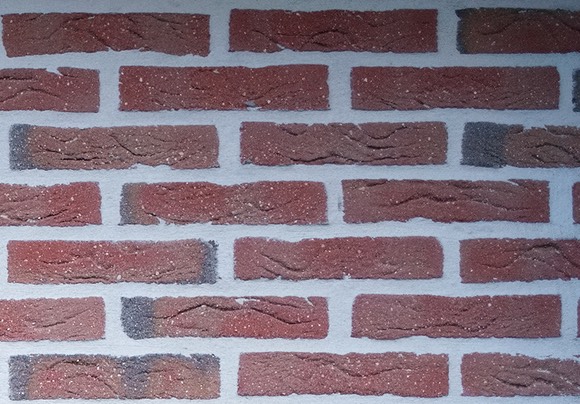
Below: Edge SX f/1.4
